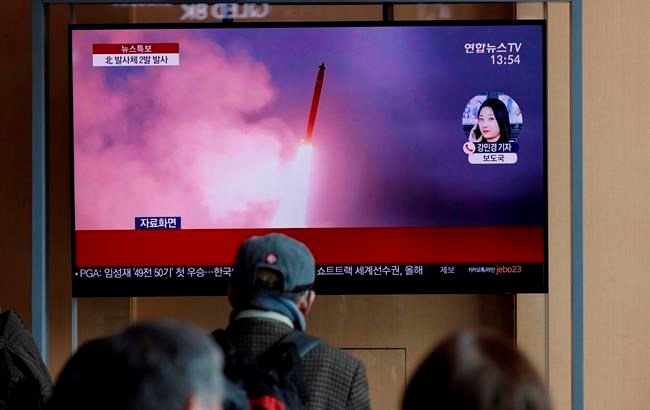SEOUL, Korea, Republic Of — North Korea fired two presumed short-range ballistic missiles into its eastern sea on Monday, South Korean officials said, resuming weapons demonstrations after a months-long hiatus that may have been forced by the coronavirus crisis in Asia.
The launches came two days after North Korea’s state media said leader Kim Jong Un supervised an artillery drill aimed at testing the combat readiness of units in front-line and eastern areas.
South Korea's Joint Chiefs of Staff said the projectiles were fired from an area near the coastal town of Wonsan and flew about 240
North Korea likely tested one of its new road-mobile, solid-fuel missile systems or a developmental “super large” multiple rocket launcher it repeatedly demonstrated last year, said Kim Dong-yub, an analyst from Seoul's Institute for Far Eastern Studies. Experts say such weapons can potentially overwhelm missile
Kim Jong Un had entered the new year vowing to bolster his nuclear deterrent in the face of “gangster-like” U.S. sanctions and pressure, using a key ruling party meeting in late December to warn of “shocking” action over stalled nuclear negotiations with the Trump administration.
He also said North Korea would soon reveal a new “strategic weapon” and insisted the country was no longer “unilaterally bound” to a self-imposed suspension on the testing of nuclear and intercontinental ballistic missiles. But Kim did not explicitly lift the moratorium or give any clear indication that such tests were impending and seemed to leave the door open for eventual negotiations.
South Korea's presidential office said National Security Director Chung Eui-yong discussed the launches with the South's
Japan said that it had not detected any projectile landing in its territory or its exclusive economic zone, and that no sea vessels or aircraft had been damaged.
“The repeated firings of ballistic missiles by North Korea is a serious problem for the international community including Japan, and the government will continue to gather and analyze information, and monitor the situation to protect the lives and property of the people," the
The recent lull in North Korea's launches had experts wondering whether the North was holding back its weapons displays while it was fighting the coronavirus, which state media has described as a matter of “national existence.” Some analysts speculated that the North cut back training and other activities involving large gatherings of soldiers to reduce the possibility of the virus spreading within its military.
Kim’s latest show of force is apparently aimed at boosting military morale, strengthening internal unity and showing that his country is doing fine despite outside worries of how the North would contend with an outbreak.
North Korea in previous years has intensified testing activity in response to springtime military exercises between South Korea and the United States that it has described as invasion rehearsals. But the allies announced last week that they were postponing their annual drills due to concern about the coronavirus outbreak in South Korea, with soldiers from both countries being infected.
The launches were the latest setback for dovish South Korean President Moon Jae-in, who despite the North’s indifference has repeatedly pleaded for reviving inter-Korean engagement. In a speech on Sunday marking the 101st anniversary of a major uprising against Japanese colonial rule, Moon called for
Amid the deadlock in larger nuclear negotiations with the Trump administration, Kim has suspended virtually all
North Korea has yet to confirm any COVID-19 cases, although state media have hinted that an uncertain number of people have been quarantined after exhibiting symptoms. North Korea has shut down nearly all cross-border traffic, banned tourists, intensified screening at entry points and mobilized tens of thousands of health workers to monitor residents and isolate those with symptoms. South Korea last month withdrew dozens of officials from an inter-Korean liaison office in Kaesong after North Korea insisted on closing it until the epidemic is controlled.
Kim and President Donald Trump have met three times since embarking on their high-stakes nuclear diplomacy in 2018, but negotiations have faltered since their second summit in February last year in Vietnam, where the Americans rejected North Korean demands for major sanctions relief in exchange for a partial surrender of its nuclear capability.
Following the collapse in Hanoi, the North ended a 17-month pause in ballistic activity and conducted at least 13 rounds of weapons launches last year, using the standstill in talks to expand its military capabilities.
Those weapons included road-mobile, solid-fuel missiles designed to beat missile
In December, the North said it conducted two “crucial” tests at a long-range rocket facility that would strengthen its nuclear deterrent, prompting speculation that it’s developing a new ICBM or preparing a satellite launch that would further advanced its long-range missile technology.
___
Associated Press writer Mari Yamaguchi in Tokyo contributed to this report.
Kim Tong-Hyung And Hyung-Jin Kim, The Associated Press



